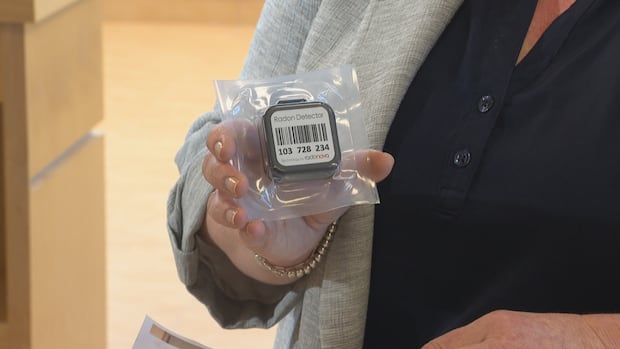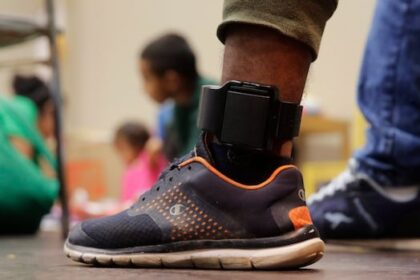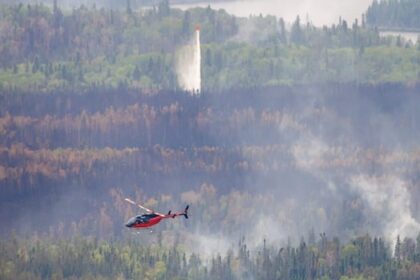New BrunswickMore than a quarter of homes sampled in the southern New Brunswick town of Grand Bay-Westfield contain unsafe levels of radon, according to a non-profit’s recent testing blitz.Take Action on Radon gave out 100 radon test kits in Grand Bay-Westfield, revealing how high levels wereLuke Beirne · CBC News · Posted: Sep 17, 2025 5:00 AM EDT | Last Updated: September 17Experts recommend installing a radon detector like this one to ensure the radioactive gas doesn’t exceed safe levels inside the home. (Curtis Hicks/CBC)More than a quarter of homes sampled in the southern New Brunswick town of Grand Bay-Westfield contain unsafe levels of radon, according to a non-profit’s recent testing blitz.One hundred homes in the town just northwest of Saint John received testing kits through Take Action on Radon, a Health Canada-financed project.Twenty-eight of those homes tested above Health Canada’s guidance for safe levels of radon, according to the group.Radon is the leading cause of lung cancer for people who don’t smoke. It’s a naturally occurring gas, caused by the breakdown of uranium in soil, but it’s radioactive and hard to detect. Radon is present in all homes but is dangerous when trapped at high levels, so Health Canada recommends everyone test their levels. “You can’t smell it, you can’t taste it, you can’t see it,” said Pam Warkentin, executive director of the Canadian Association of Radon Scientists and Technologists.”The only way to know what level is in your home is to test for it.” Take Action on Radon sends radon test kits to communities across Canada where radon testing is uncommon. Grand Bay-Westfield is one of more than 160 communities across Canada to take part in the 100 Radon Test Kit Challenge.Andrew Shipley, owner of the Quispamsis-based remediation company Radon Plus, said the sample taken in Grand Bay-Westfield is on par with what he sees across the province, noting about 25 per cent of homes in New Brunswick exceed Health Canada guidelines.Shipley recommends leaving a long-term radon test kit in your home for 100 days to test the levels before mitigation steps, a strategy that Health Canada also endorses.Radon enters homes because “the air pressure inside your home is usually lower than in the soil surrounding the foundation,” says a Health Canada page on radon. “This difference in pressure draws air and other gases, including radon, from the soil into your home.”Lowering levelsShipley said radon levels can be reduced to safe levels by “essentially creating a vacuum beneath a home” and sucking the radon out into the air. He said the system he uses is 98 per cent effective in removing the gas.”Usually within 24 hours your radon levels are down to … safe levels,” he said. Pam Warkentin said that Health Canada recommends taking mitigation steps within a year of radon detection. (Robert Lowdon/Submitted by Pam Warkentin)In addition to test kits, he says people should install radon detectors in their houses alongside their smoke detectors and carbon monoxide detectors, because the levels in New Brunswick are very high.”That would save a lot of lives,” he said.N.B. levels among highest in countryWarkentin said high radon levels aren’t uncommon in New Brunswick. In fact, the province has one of the highest radon levels in Canada. “What people don’t realize is it’s in every house,” Shipley said. “We all have it in our houses, just at different levels. It’s not something we need to be scared about. We just need to learn about it, test for it, and it can be fixed easily.”Warkentin said Health Canada recommends taking mitigation steps within a year of detecting an unsafe level. Reducing the level isn’t difficult, she said. “Mitigation professionals can come in and help people with reducing the radon level,” she said. “It usually takes about one day and when it’s installed by a professional, it’s really effective at reducing levels to quite low.”The radon remediation process usually costs around $3,000, which might cause some people to avoid addressing it. A grant is available from Canadian Lung Association for $1,500 to cover part of the cost.ABOUT THE AUTHORLuke Beirne is a researcher at CBC News in Saint John. He is also a writer and the author of three novels. You can reach him at luke.beirne@cbc.ca.
28 of 100 homes tested in Grand Bay-Westfield show dangerous levels of radon











